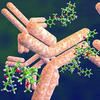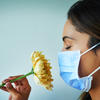You are here
When the immune system goes haywire

What is an allergy? And why do some people react to elements such as pollen?
Sophie Laffont1: Allergy is an excessive reaction by the immune system to substances that are normally innocuous (allergens) such as pollens, dust mites or particular foods. In other words, it is a disproportionate inflammatory response to molecules which, in principle, are not dangerous. This imbalance causes symptoms such as sneezing, itching or even allergic asthma.
Why are some people allergic and others not?
S. L.: A combination of genetic and environmental factors is in play. If one or both parents are allergic, the risk of developing an allergy is higher. There is also the hygiene theory2, formulated in 1989 by David P. Strachan3, who suggested that our sanitised lifestyle may prevent our immune system from training to deal with external attack, thus making it more sensitive to harmless substances such as pollen.

Finally, pollution and exposure to chemicals including washing powders or perfumes4 alter our natural barriers – such as the skin – and disturb the immune response, further worsening allergic reactions. There is also an environmental factor, notably linked to climate change, which results in prolonged and intensified pollination periods and the emergence of new allergenic plants. It is also exacerbating air pollution and the proliferation of moulds, thereby contributing to an increase in allergies.
What happens in the body during an allergic reaction?
S. L.: The immune system reacts to an allergen by triggering an inflammatory cascade. Specialised immune cells like mastocytes release substances including histamine that cause the symptoms: a runny nose, weeping eyes or breathing difficulties, etc.

It seems that some allergic reactions – such as those associated with pollen – appear to trigger others.
S. L.: Yes, indeed, allergies can be worsened by so-called crossover reactions. The immune system recognises small pieces of proteins5 that are common to different families of allergens. For example, a person who is allergic to birch pollen may also react when eating an apple! In this case, proteins from the same family, with a very similar structure, may be present in both birch pollen and in fruits such as apples, pears or peaches. When someone allergic to birch pollen eats these fruits, their immune system identifies these proteins as a threat and triggers an allergic reaction similar to that caused by pollen. This phenomenon explains why people may experience tingling or swelling in the mouth after eating this type of food.
Luckily, these proteins are generally temperature-sensitive, which means that they lose their properties above a certain temperature. For this reason, cooked foods are often better tolerated by allergic individuals.
Do allergies vary depending on regions or seasons?
S. L.: Yes, absolutely. Seasonal allergies depend on the types of pollen present in the air at different times of the year. In spring, we are more exposed to tree pollens such as birch or oak, while in summer, it is grass and herbaceous plants that predominate, creating a sort of natural allergy calendar that evolves over the seasons.
Allergies can also vary as a function of regions. Even within a country like France, the same plants are not found everywhere. For example, allergy to olive trees is common in the south (where these trees are widespread) but much rarer in the north.
To sum up, allergic symptoms can change depending on the region and time of the year, as well as on the plants present and their flowering periods.
What treatments are available at present?
S. L.: The standard treatments are antihistamines (which block the action of histamine) and bronchodilators such as ventolin, which relieve asthma. In the most severe cases, monoclonal antibodies targeting key molecules in the immune response are able to alleviate inflammation in a more specific manner.
There is also allergen immunotherapy (or desensitisation) which consists in gradually exposing the body to small quantities of allergen until it becomes habituated. In the long term, this can enable someone to no longer be allergic or benefit from a marked reduction in symptoms.
Other treatments are based on monoclonal antibodies, or antibodies produced in the laboratory to be identical and highly specific to their target. For example, they can neutralise type E immunoglobulins (IgE), the molecules that trigger allergy by recognising allergens and activating histamine release. Another area of research concerns the blockade of cytokines, small messenger molecules produced by the immune system which orchestrate the inflammatory response. By blocking these signals, it is possible to calm inflammation before it becomes troublesome.
These latest-generation treatments are showing real potential. However, their high cost when compared to antihistamines means that they are currently reserved for use in the most severely affected patients.
Do allergic reactions vary depending on the sex of individuals?
S. L.: Yes, clearly, and sex hormones6 play an important role in this setting. For example, boys are affected more than girls by allergic asthma during childhood, but after puberty it is adult women who are more impacted, often with the most severe forms.
Androgens (male sex hormones such as testosterone) appear to exert a protective effect by hampering the activity of the immune cells involved in allergic inflammation. These cells include type-2 innate lymphoid cells (ILC2), a type of immune cell that was first described in the early 2000s and plays a key role in inflammation of the respiratory tract in an allergic context. On the other hand, oestrogens (female sex hormones) may tend to amplify this reaction.
Are therapies being developed to overcome these differences in reaction between men and women?
S. L.: Yes, we are exploring different opportunities, using in particular an androgen precursor that may help women suffering from allergic asthma. Another solution consists in directly targeting the cells implicated in inflammation, again by means of immunotherapy, in order to better control the disease. We are starting to improve our understanding of the effects of hormones on allergy, and this is a major step towards more personalised treatments. In the meantime, keep your antihistamines at hand, and avoid eating raw apples if you are allergic to birch pollen! ♦
See also
A new antibody for fighting cancer
The exposome, exposure of a lifetime
The truth behind the placebo effect
- 1. CNRS research professor at the Toulouse Institute for Infectious and Inflammatory Diseases (INFINITy – CNRS / INSERM / Université de Toulouse).
- 2. Strachan DP. “Hay fever, hygiene, and household size”, BMJ. 1989 Nov 18;299(6710):1259-60. doi: 10.1136/bmj.299.6710.1259. PMID: 2513902; PMCID: PMC1838109.
- 3. British epidemiologist and Emeritus Professor.
- 4. Laaidi, M., Chinet, T., & Aegerter, P. (2011). “Allergies au pollen, pollution et climat : revue de la littérature”. Revue Française d’Allergologie, 51(7), 622-628. https://doi.org/10.1016/j.reval.2011.05.004
- 5. Poncet, P., & Sénéchal, H. (2019). “Actualités des réactions croisées pollen-aliment”, Revue Française d’Allergologie, 59(8), 543-554. https://doi.org/10.1016/j.reval.2019.09.005
- 6. Anesi N, Calmels M, Guilleminault L, Abbas F, Cenac C, Villeneuve T, de Bonnecaze G, Laffont S, Guéry JC. “In Asthmatic Patients, Sexual Dimorphism Correlates With Androgen Receptor. Expression in ILC2s at Single Cell-Resolution”, Clin Exp Allergy. 2025 Apr 3. doi: 10.1111/cea.70047. Epub ahead of print. PMID: 40177983

















